emergency towing AUDI A6 2015 Owners Manual
[x] Cancel search | Manufacturer: AUDI, Model Year: 2015, Model line: A6, Model: AUDI A6 2015Pages: 314, PDF Size: 77.57 MB
Page 5 of 314
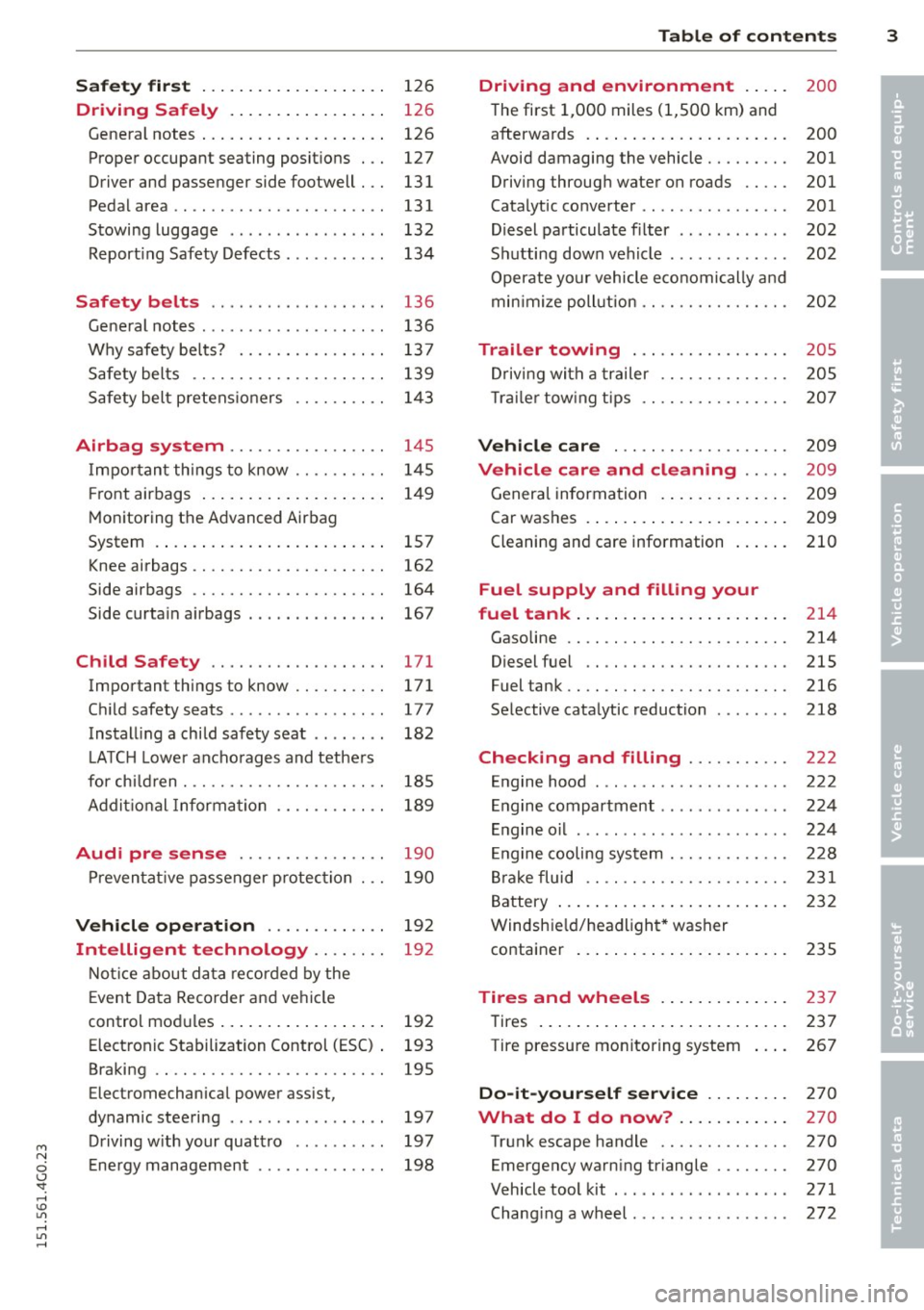
M N
0 <.J 'SI: ,...., \!) ..,.,
,...., ..,., ,....,
Safet y fir st . . . . . . . . . . . . . . . . . . . . 126
Driving Safely . . . . . . . . . . . . . . . . . 126
General notes . . . . . . . . . . . . . . . . . . . . 126
Proper occupant seating posit ions . . . 127
Driver and passenger side footwell . . . 131
Pedalarea .. .. .............. ... .. 131
Stowing luggage . . . . . . . . . . . . . . . . . 132
R eport ing Safety Defects . . . . . . . . . . . 134
Safety belts ... .. ...... .. .. .. . .
General notes ............... .. .. .
Why safety bel ts? ........ .... .. . .
Safety belts ............. .. .. .. . .
Safety belt p re tens ioners .. .. .. .. . .
Airbag system ........... .. .. . .
Impor tant th ings to know .. .. .. .. . .
Fr ont airbags ... ...... ... .. .. .. . .
M onitoring the Advanced Airbag
System .... .. .... .. .... ... .. .. . .
Knee airbags ............. .... .. . .
Side airbags .. ........... .. .. .. . .
Side curta in a irbags ........ . .... . .
Ch ild Safety ............... .. . .
Important things to know .. .. .. .. . .
C hi ld safety seats ............ .... .
Install ing a chi ld safety seat .. .. ... .
L A TC H L ower ancho rages and tethe rs
fo r ch ild ren . ............. .... .. . .
Addit io nal Informa tion
Audi pre sense .......... .. .. . .
Pr even ta ti ve passe nger p rotec tion
Vehicle operation ....... .. .. . .
Intelligent technology .. .. .. . .
N ot ice about da ta re corded by the
E vent Data Recorder and vehi cle
control mod ules ... .... ... .. .. .. . .
Elect ronic Stabilization Control (ESC) . 136
136
137
139
1
4 3
145
1 4 5
1 4 9
157
162 164
167
171
171
177
182
185
189
190
190
19 2
19 2
192
193
Braking . . . . . . . . . . . . . . . . . . . . . . . . . 195
Electromechanical power assist,
dynamic steering . . . . . . . . . . . . . . . . . 197
Driving w ith your quattro . . . . . . . . . . 197
E ne rgy management . . . . . . . . . . . . . . 198
Table of contents 3
Driving and environment . . . . .
200
T he first 1,000 miles (1 ,500 km) and
afterwa rds . . . . . . . . . . . . . . . . . . . . . . 200
Avoid damaging the vehicle. . . . . . . . . 201 Driving through water on roads . . . . . 201
Catalytic co nverter . . . . . . . . . . . . . . . . 201
D iesel pa rticulate filter . . . . . . . . . . . . 202
S hu tting down vehi cle . . . . . . . . . . . . . 202
Operate your vehicle e conomically and
min imi ze poll ution . . . . . . . . . . . . . . . . 202
Trailer towing . . . . . . . . . . . . . . . . . 205
Dr iving wit h a trailer . . . . . . . . . . . . . . 205
T ra ile r tow ing t ips . . . . . . . . . . . . . . . . 207
Vehicle care . . . . . . . . . . . . . . . . . . . 209
Vehicle care and cleaning . . . . . 209
Genera l informa tion . . . . . . . . . . . . . . 209
Car was hes . . . . . . . . . . . . . . . . . . . . . . 209
Cleaning and care information . . . . . . 210
Fuel supply and filling your
fuel tank ... .. .... . ... ...... ... .
214
Gasoline . . . . . . . . . . . . . . . . . . . . . . . . 214
Diesel fuel . . . . . . . . . . . . . . . . . . . . . . 215
Fuel tank.. .. .. .. .. .. ........... . 216
Se lective cata lytic reduction . . . . . . . . 218
Checking and filling . . . . . . . . . . . 222
Engine hood . . . . . . . . . . . . . . . . . . . . . 222
En gine compartment . . . . . . . . . . . . . . 224
E ngine o il . . . . . . . . . . . . . . . . . . . . . . . 224
En gine cooling system . . . . . . . . . . . . . 228
Br ake fluid . . . . . . . . . . . . . . . . . . . . . . 231
Battery . . . . . . . . . . . . . . . . . . . . . . . . . 232
Windshie ld/headlight * washer
co ntainer . . . . . . . . . . . . . . . . . . . . . . . 235
Tires and wheels . . . . . . . . . . . . . . 237
T ires . . . . . . . . . . . . . . . . . . . . . . . . . . . 237
Tire pressure mo nitoring system 267
Do-it-yourself service . . . . . . . . . 270
What do I do now? . . . . . . . . . . . . 270
Tr unk escape handle . . . . . . . . . . . . . . 270
Emergency warn ing triangle . . . . . . . . 270
Vehicle tool kit . . . . . . . . . . . . . . . . . . . 271
Chang ing a wheel . . . . . . . . . . . . . . . . . 272
•
•
Page 6 of 314
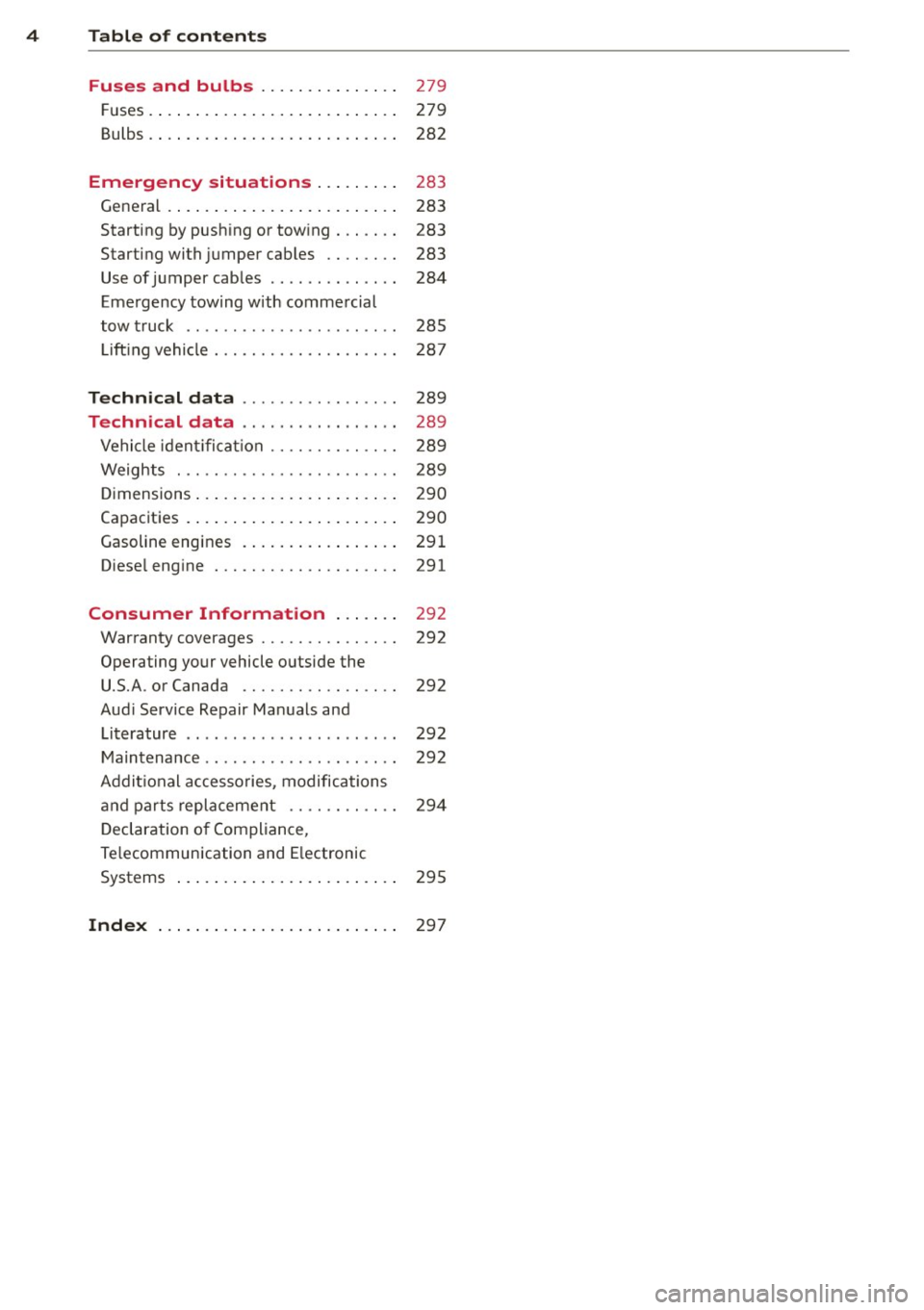
4 Table of contents
Fuses and bulbs . . . . . . . . . . . . . . .
279
F uses. . . . . . . . . . . . . . . . . . . . . . . . . . . 279
Bulbs. ... .. ... ... .... ... .. .. .... 282
Emergency situations . . . . . . . . . 283
General . . . . . . . . . . . . . . . . . . . . . . . . . 283
Starting by push ing or tow ing . . . . . . . 283
Starting with jumper cables . . . . . . . . 283
Use of jumper cab les . . . . . . . . . . . . . . 284
Eme rgency towing with commercial
tow truck . . . . . . . . . . . . . . . . . . . . . . . 285
Lift ing vehicle . . . . . . . . . . . . . . . . . . . . 287
Technical data . . . . . . . . . . . . . . . . . 289
Technical data . . . . . . . . . . . . . . . . . 289
Vehicle ident ifica tion . . . . . . . . . . . . . . 289
Weights . . . . . . . . . . . . . . . . . . . . . . . . 289
D imensions .... .. ..... ... .. .. ... . 290
Capacities . . . . . . . . . . . . . . . . . . . . . . . 290
Gasoline engines . . . . . . . . . . . . . . . . . 291
Diese l eng ine . . . . . . . . . . . . . . . . . . . . 291
Consumer Information . . . . . . . 292
Warranty coverages . . . . . . . . . . . . . . . 292
Operating your vehicle outside the U.S.A. or Canada . . . . . . . . . . . . . . . . . 292
Audi Service Repair Manuals and Literature . . . . . . . . . . . . . . . . . . . . . . . 292
M aintenance . . . . . . . . . . . . . . . . . . . . . 292
Addit ional accesso ries, modifications
and parts replacement . . . . . . . . . . . . 294
D eclaration o f Compliance,
Te lecommunication and E lectronic
Systems . . . . . . . . . . . . . . . . . . . . . . . . 295
Inde x . . . . . . . . . . . . . . . . . . . . . . . . . . 297
Page 25 of 314
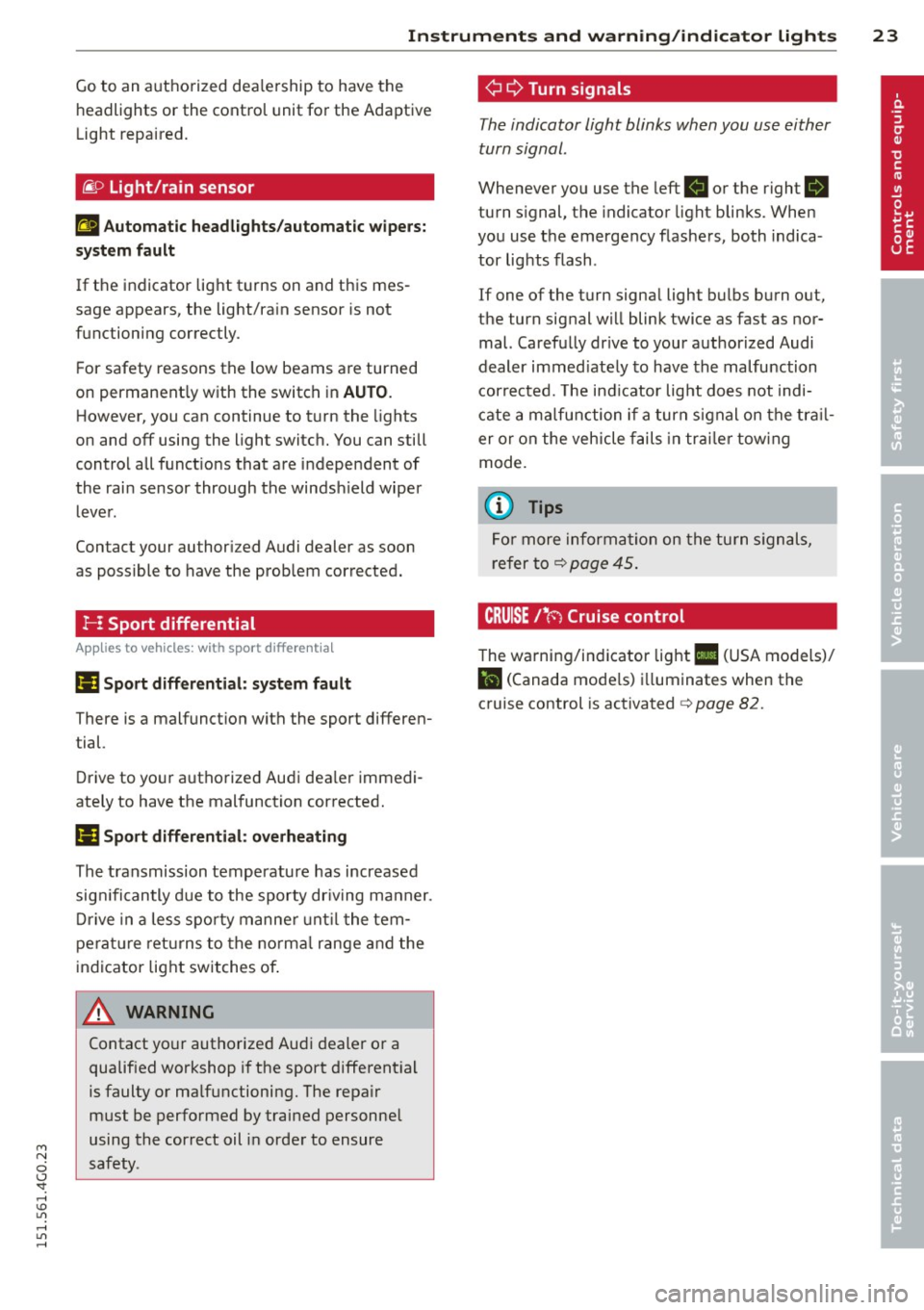
M N
0 <.J 'SI: ,...., \!) 1.1'1 ,...., 1.1'1 ,....,
Instruments and warning/indicator lights 23
Go to an authorized dea lership to have the
headlights or the contro l unit for the Adaptive
Light repaired.
fi.D Light/rain sensor
El Automatic headl ights/automatic wipers:
system fault
If the indicator light t urns on and this mes
sage appears, the light/rain sensor is not
functioning correctly .
F or safety reasons the low beams are turned
on permanent ly with the switch in
AUTO.
However, you can continue to turn the lights
on and off using the light switch. You can still
control all funct ions that are independent of
the rain sensor through the windsh ield wiper
lever .
Contact your author iz ed Audi dealer as soon
as possible to have the problem corrected.
I-: Sport differential
App lies to vehicles: with sport different ia l
IIJ Sport differential: system fault
There is a malfunct ion with the sport differen
tial.
Drive to your authorized Audi dea ler immedi
ately to have the malfunction corrected.
IIJ Sport differential : overheating
The transmission temperature has increased
sig nificantly due to the sporty dr iv ing manner .
Dri ve i n a less sporty manner until the tem
perature returns to the normal range and the
indicator light switches of .
A WARNING
Contact your authorized Audi dealer or a
qualif ied workshop if the sport differential
is faulty or ma lfunctioning. The repa ir
must be performed by trained personnel
using the correct oil in order to ensure
safety .
-
¢ Q Turn signals
The indicator light blinks when you use either
turn signal .
Whenever you use the left . or the right 1B
turn s ignal, the indicator light blinks. When
you use the emergency flashers, both indica
tor lights flash .
If one of the turn signa l light bulbs burn out,
the turn signal will blink twice as fast as nor
mal. Carefully dr ive to your authorized Audi
dealer immed iately to have the malfunction
corrected. The ind icator light does not indi
cate a malfunction if a turn signal on the trail
er or on the vehicle fails in trailer towing
mode.
(D Tips
For more information on the turn signals,
refer to
q page 45.
CRUISE/' (-) Cruise control
The warning/indicator light Ill (USA models)/
l'I (Canada mode ls) illuminates when the
cruise control is activated
q page 82.
Page 46 of 314
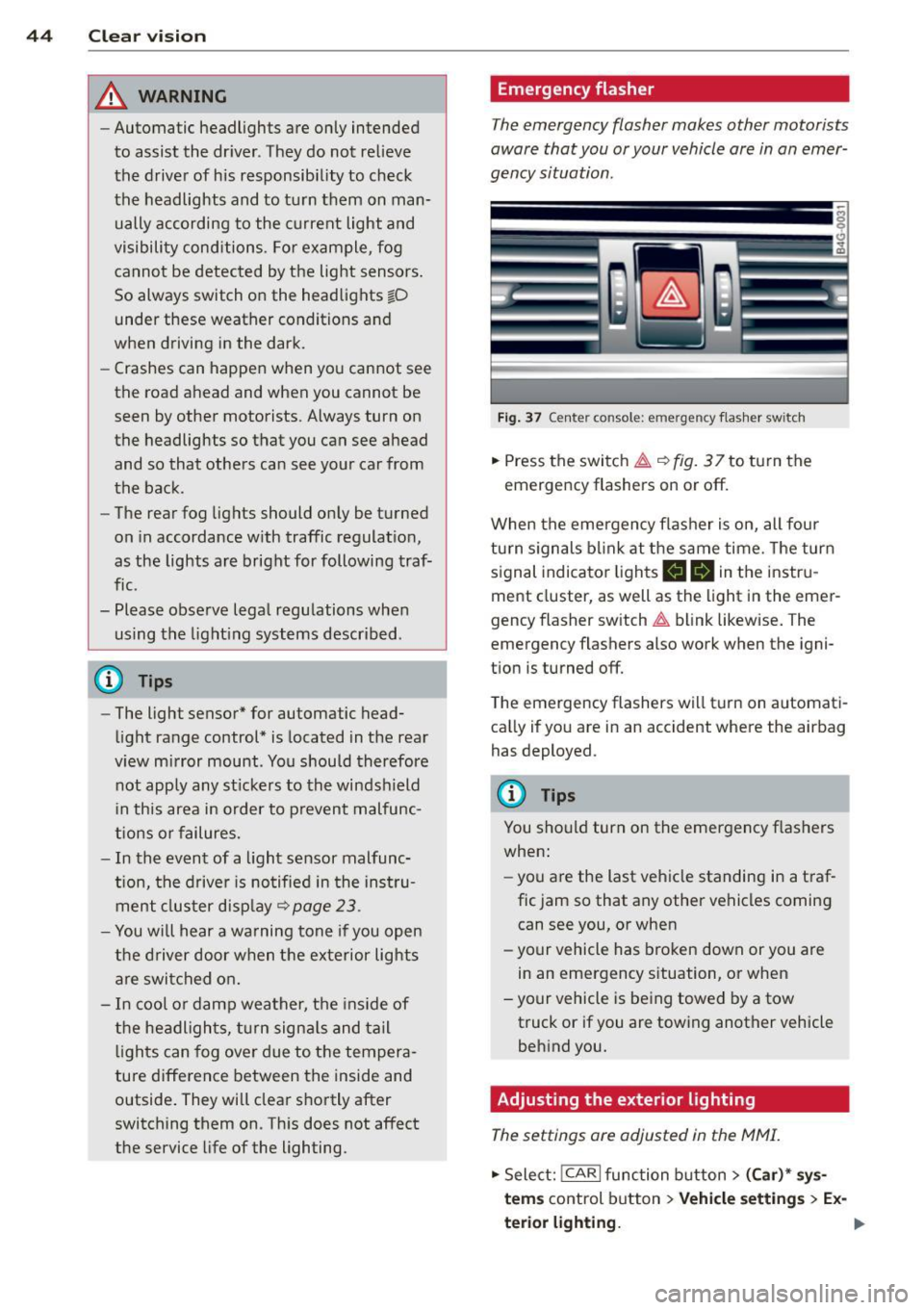
44 Clear vision
& WARNING
- Automatic headlights are only intended
to assist the driver . They do not relieve
the driver of his responsibility to check
the headlights and to turn them on man
ually according to the current light and
visibility conditions. For example, fog
cannot be detected by the light sensors.
So always switch on the headlights
io
under these weather conditions and
when driving in the dark.
- Crashes can happen when you cannot see
the road ahead and when you cannot be
seen by other motorists. Always turn on
theheadlightssothatyoucanseeahead and so that others can see your car from
the back .
- The rear fog lights should only be turned
on in accordance with traffic regulation,
as the lights are bright for following traf
fic.
- Please observe legal regulations when using the lighting systems described .
@ Tips
-The light sensor* for automatic head
light range control* is located in the rear
view mirror mount . You should therefore
not apply any st ickers to the windshield
in this area in order to prevent malfunc
tions or failures.
- In the event of a light sensor malfunc
tion, the driver is notified in the instru
ment cluster display
Q page 2 3 .
-You will hear a warning tone if you open
the driver door when the exterior lights
are switched on.
- In cool or damp weather, the inside of
the headlights, turn signa ls and tail
lights can fog over due to the tempera
ture difference between the inside and
outside. They will clear shortly after
switching them on. This does not affect
the service life of the lighting.
Emergency flasher
T he emergency flasher makes other motorists
aware that you or your vehicle are in an emer
gency situation .
Fig. 37 C ente r co nso le: em erg en cy flash er sw it ch
.. Press the switch ~ Q fig. 3 7 to turn the
emergency flashers on or off.
When the emergency flasher is on, all four
turn s ignals blink at the same time. The turn
signal indicator lights
11111 in the instru
ment cluster, as well as the light in the emer
gency flasher switch~ blink likewise. The
emergency flashers also work when the igni
tion is turned off.
The emergency flashers will turn on automati
cally if you are in an accident where the airbag
has deployed.
@ Tips
You should turn on the emergency flashers
when:
- you are the last vehicle standing in a traf
fic jam so that any other vehicles coming
can see you, or when
- your vehicle has broken down or you are
in an emergency situation, or when
-your vehicle is being towed by a tow
truck or if you are towing another vehicle
behind you.
Adjusting the exterior lighting
The settings are adjusted in the MMI.
.. Select: !CARI function button> (Car)* sys
tems
control button > Vehicle setting s > Ex-
terior lighting.
Ill>
Page 77 of 314
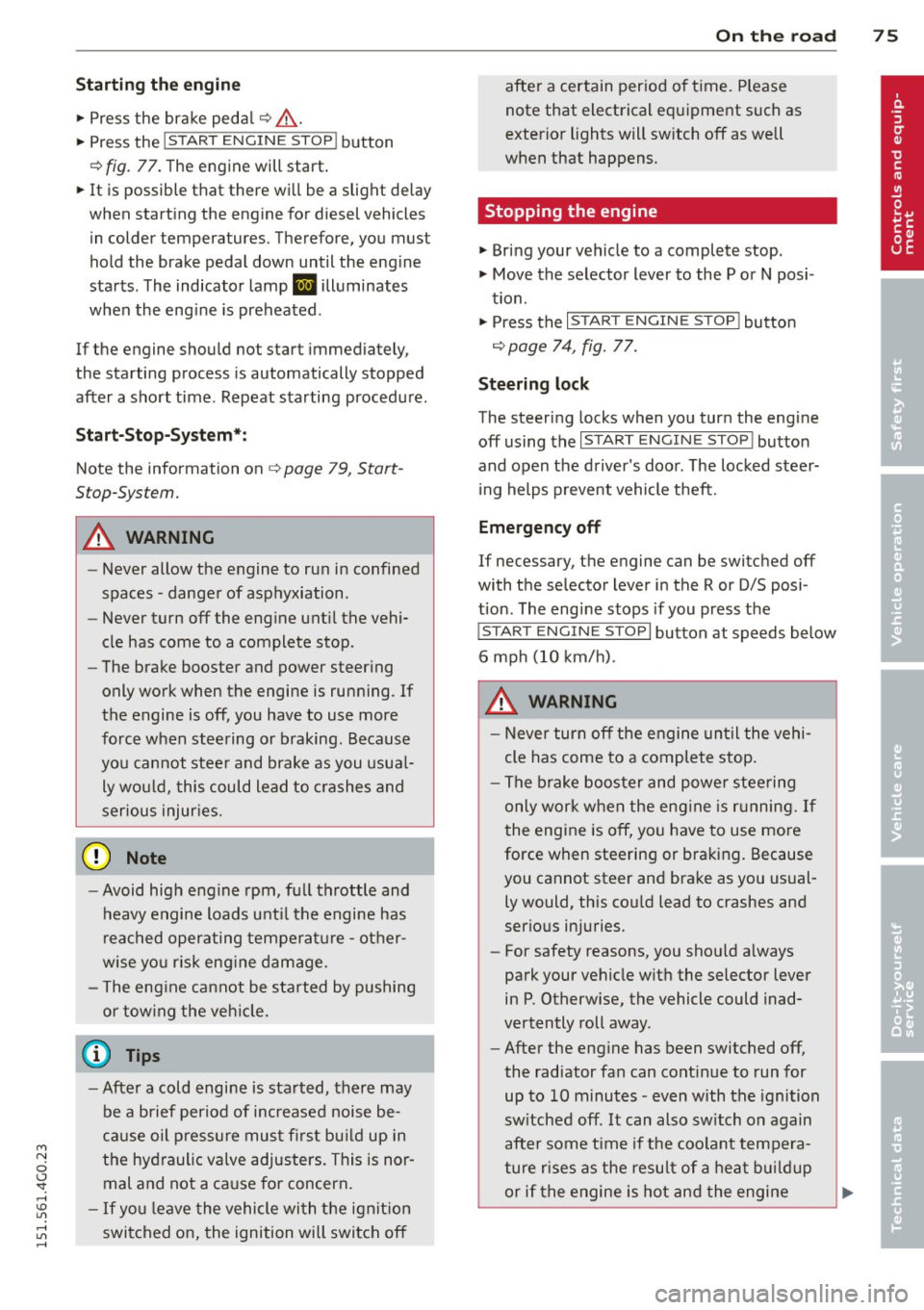
M N
0 <.J 'SI: ,...., \!) ..,.,
,...., ..,., ,....,
Starting the engine
"'Press the brake pedal c::> _&..
"'Pr ess the !START ENGINE STOPI button
c::> fig. 77. The engi ne will start.
"' It is possible that there will be a slight delay
when starting the engine for diesel vehicles
in colder temperatures. Therefore, you must
hold the brake pedal down until the engine
starts. The indicator lamp
Ii illuminates
when the engine is preheated.
If the engine should not start immedi ately,
the starting process is automatically stopped
after a short time . Repeat starting procedure.
Start-Stop-System*:
Note the information on c::> page 79, Start
Stop-System.
A WARNING
- Never allow the engine to run in confined
spaces -danger of asphyxiation .
- Never turn off the engine until the vehi
cle has come to a complete stop.
- The brake booster and power steering
only work when the engine is running.
If
the engine is off, you have to use more
force when steering or braking. Because
you cannot steer and brake as you usual
ly would, this could lead to crashes and
serious injuries.
-Avoid high engine rpm, full throttle and
heavy engine loads until the engine has
reached operating temperature - other
wise you risk engine damage.
- The engine cannot be started by pushing
or towing the vehicle.
(D Tips
-After a cold engine is started, there may
be a brief period of increased noise be
cause oil pressure must first build up in
the hydraulic valve adjusters. This is nor mal and not a cause for concern.
- If you leave the vehicle with the ignition
switched on, the ignition will switch off
On the road 75
after a certain period of time. Please
note that electrical equipment such as
exterior lights will switch off as well
when that happens.
Stopping the engine
"'Bring your vehicle to a complete stop.
"' Move the selector lever to the P or N posi
tion .
"'Press the
I STAR T ENGINE ST OP I button
c::> page 7 4, fig. 77.
Steering lock
The steer ing locks when you turn the engine
off using the
I STAR T ENGINE STOP I button
and open the driver's door. The locked steer ing helps prevent vehicle theft.
Emergency off
If necessary, the engine can be switched off
with the selector lever in the R or D/S posi
tion. The engine stops if you press the
I START ENGINE STOPI button at speeds below
6 mph (10 km/h).
A WARNING
-Never turn off the engine until the vehi
cle has come to a complete stop.
- The brake booster and power steering
only work when the engine is running. If
the engine is off, you have to use more
force when steering or braking. Because
you cannot steer and brake as you usual
ly would, this could lead to crashes and
serious injuries.
- For safety reasons, you should always
park your vehicle with the selector lever
in P. Otherwise, the vehicle could inad
vertently roll away.
- After the engine has been switched off,
the radiator fan can continue to run for
up to 10 minutes -even with the ignition
switched off.
It can also switch on again
after some time if the coolant tempera
ture rises as the result of a heat buildup
.
or if the engine is hot and the engine .,..
Page 274 of 314
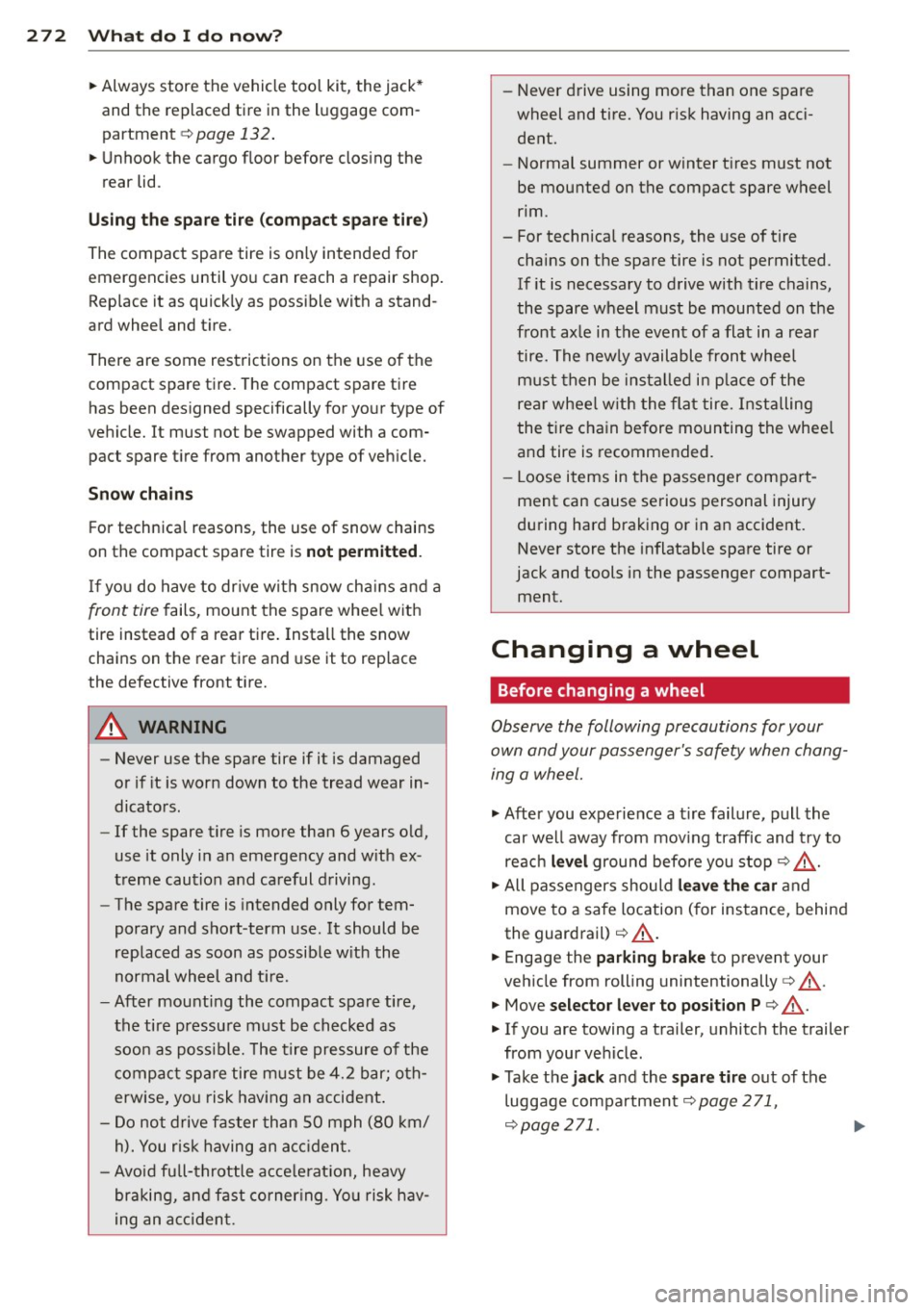
272 What do I do no w?
• Always store the vehicle too l kit, the jack*
and the replaced tire in the luggage com
partment
¢ page 132.
• Unhook the cargo floor before clos ing the
rear lid.
Using th e spare tir e (compac t spare tir e)
The compact spare tire is on ly intended for
emergencies until yo u can reach a repair shop.
Replace it as quickly as possible with a stand
ard wheel and tire.
There are some restrictions on the use of the compact spare tire. The compact spare tire has been des igned specifically for your type of
vehicle. It must not be swapped with a com pact spare tire from another type of vehicle.
Sn ow chain s
For technical reasons, the use of snow chains
on the compact spare tire is
not permitt ed .
If you do have to dr ive with snow cha ins and a
front tire fails, mount the spare wheel with
tire instead of a rear tire . Install the snow
chains on the rear tire and use it to replace
the defective front tire.
A WARNING
- Never use the spare tire if it is damaged
or if it is worn down to the tread wear in
dicators .
- If the spare tire is more than 6 years o ld,
use it only in an emergency and with ex
t reme caution and careful driving .
- The spare tire is intended only for tem
porary and short-term use. It should be
replaced as soon as possible w ith the
normal wheel and t ire.
- After mounting the compact spare tire,
the tire pressure must be checked as
soon as poss ible. The tire pressure of the
c ompact spare tire must be 4.2 bar; oth
erwise, you risk hav ing an accident .
- Do not drive faster than 50 mph (80 km/
h). You risk having an acc iden t.
- Avoid full-throttle acce le rat ion, heavy
braking, and fast corner ing . You risk hav
ing an a cc ident. -
Never drive using more than one spare
wheel and tire. You r isk having an acci
dent.
- Normal summer or winter tires must not
be mounted on the compact spare wheel
rim.
- For technical reasons, the use of tire
chains on the spare tire is not permitted.
If it is necessary to drive with tire chains,
the spare wheel must be mounted on the
front ax le in the event of a flat in a rear
tire. The new ly available front wheel
m ust then be installed in place of the
rear whee l w ith the flat tire. Installing
the tire chain before mounting the whee l
and tire is recommended.
- Loose items in the passenger compart
ment can cause serious personal injury
during hard braking or in an accident. Never store the inflatable spare tire or
jack and tools in the passenger compart ment.
Changing a wheel
Before changing a wheel
Observe the following precautions for your
own and your passenger's safety when chang
ing a wheel.
• After you experience a t ire failure, pull the
car well away from mov ing traffic and t ry to
reach
l e vel ground before you stop ¢ ,&.
• All passengers should leave th e car and
move to a safe location ( for instance, behind
the guardrail) ¢,& .
• Engage the
par king brake to prevent your
vehicle from rolling unintentionally c> _& .
• Move
selector le ver to pos it ion P c> _& .
• If you are towing a trailer, unhitch the trailer
from your vehicle.
• Take the
jack and the spare tir e out of the
luggage compa rtment c>
page 271,
i=> page 271 . ..,_
Page 285 of 314
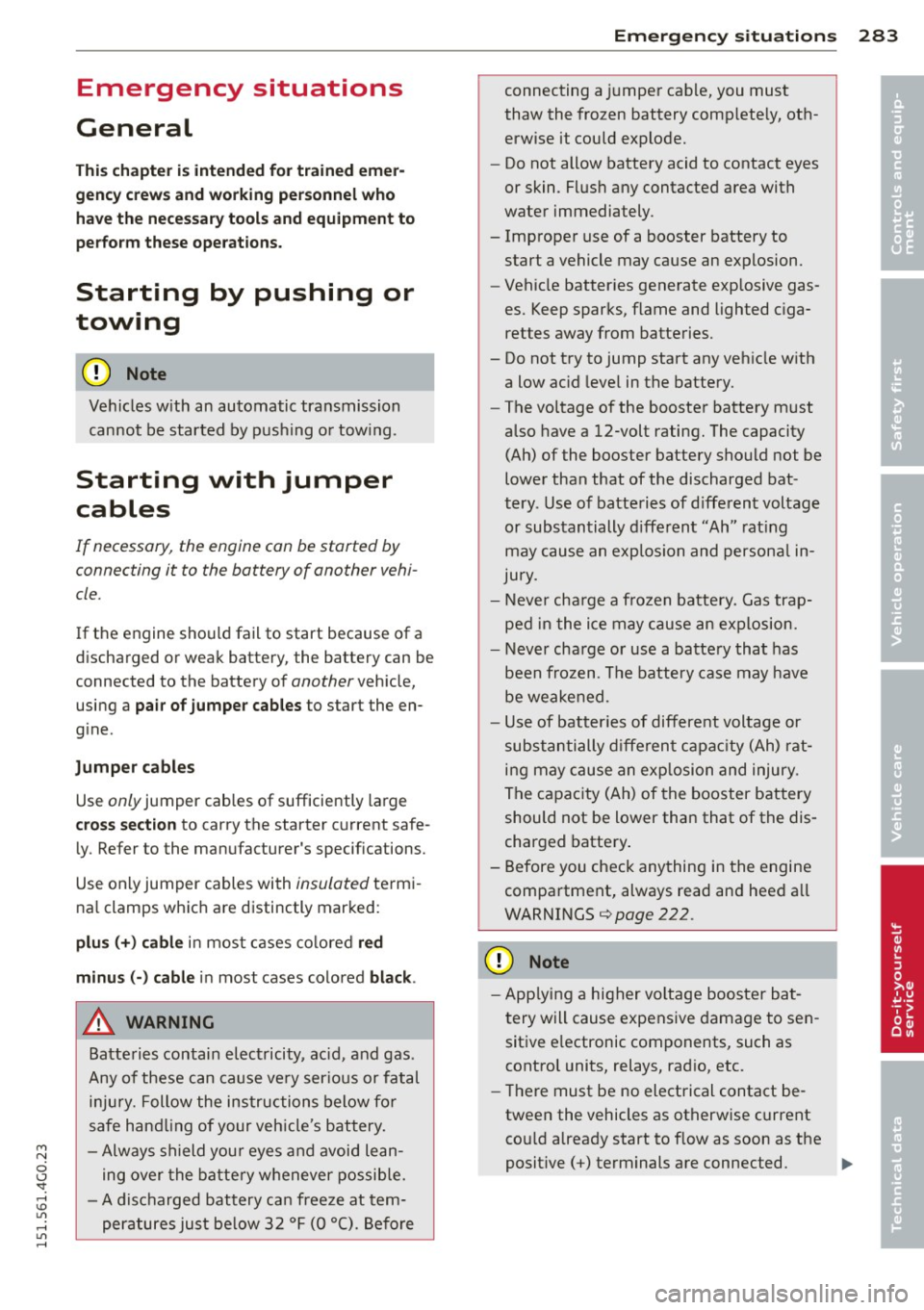
M N
0 <.J 'SI: ,...., \!) ..,.,
,...., ..,., ,....,
Emergency situations
General
This chapter i s intended for trained emer
gency crews and working personnel who have the necessary tools and equipment to
perform these operations.
Starting by pushing or
towing
(D Note
Ve hicles w ith an au tomatic tra nsmission
cannot be started by pus hing o r tow ing.
Starting with jumper
cables
If necessary, the engine can be started by
connecting it to the battery of another vehi
cle.
If the engine shou ld fail to start because of a
discha rged o r wea k battery, the battery can be
connected to the battery o f
another vehicle,
using a
pair of jumper cables to start the en
g ine.
Jumper cables
Use only jumper cables of sufficiently la rge
c ross section to carry the starter c urrent safe
l y. Refer to the man ufacturer's specifications.
Use only jumper cables with
insulated te rm i
na l clamps wh ic h are d istinctly marked:
plus(+) cable i n mos t cases co lore d red
minu s(-) cable
in most cases colored black .
A WARNING
Batterie s contain e lec tricity, ac id, an d gas.
A ny of these can cause ve ry ser io us or fatal
inju ry. Follow the instructions below f or
safe han dling of your veh icle's b attery .
- Alway s shield you r eyes and avoid lean
ing over the bat te ry whenever possib le.
- A dis ch arged battery c an free ze at tem
peratures ju st be low 32 °F ( 0 °C ). Befo re
Emergency situations 283
connecting a jumpe r cab le, you must
thaw the fr ozen battery c omp lete ly, ot h
erwise it could explode.
- Do not allow battery acid to contact eyes
or skin. Fl ush any contacted area with
wate r immediately.
- Improper use of a booster battery to start a vehicle may cause an explosion.
- Vehicle batter ies genera te exp losive gas
es. Keep spar ks, flame and lighted c iga
rettes away from batte ries.
- Do not try to jump start any ve hicle w ith
a low ac id leve l in the battery.
- The vo ltage of the booste r batte ry m ust
a lso have a 12-volt rating. The capacity
(Ah) of the booster battery sho uld not be
lowe r tha n that of the discharged bat
tery . U se of batte rie s of d iffe ren t voltage
or substantially diffe rent "Ah" rat ing
may c au se an exp losion and persona l in
JU ry.
- N ever cha rge a fro zen battery. Gas trap
pe d in the ice may cause a n ex plosion.
- Never cha rge or use a batte ry tha t h as
been fr ozen. T he battery case may have
be weakened.
- Us e of b atter ies of differe nt voltage or
sub stant ia lly diffe ren t ca pa city (Ah) ra t
i ng may c ause an ex plosion an d injury .
Th e capac ity (Ah) of the booster bat tery
should not be lower than that of the dis
charged batte ry .
- Before you chec k any thing in the engine
compa rtment, always read and hee d all
WARNINGS¢
page 222.
(D Note
- App lyin g a higher vo ltage booster ba t
t ery w ill cause expens ive damage to se n
sit ive e lectronic com ponents, such as
cont ro l units, relays, rad io, etc.
- The re must be no electrical contact be
tween the vehicles as ot herwise c urrent
co uld a lready start to f low as soon as the
p o sit ive(+) term inals a re connected. ..,. •
•
Page 287 of 314

M N
0 I.J "". rl I.O
"' rl
"' rl
-When connecting jumper cables, make
sure that they cannot get caught in any
moving parts in the eng ine compart
ment .
- Before you check anything in the engine
compartment, always read and heed all
WARNINGS
¢ page 222.
(D Note
Improper hook-up of jumper cables can r u
in the generator.
- Always connect POSITIVE( +) to POSI
TIVE(+), and NEGATIVE(-) to NEGATIVE
( - ) gro und post of the battery manager
control unit .
- Check that all screw plugs on the battery
cells a re screwed in firmly . If not, tighten
pl ugs p rior to connecting clamp on nega
tive battery term inal.
- Please note that the procedure f or con
nect ing a jump er cable as desc ribed
above appl ies spec ifically to the case of
you r vehi cle be ing jump started. When
you are giv ing a jump star t to an othe r ve
hi cle, do
not connec t the negat ive (-) ca
ble to the negat ive (-) terminal on the
discharged battery@¢fig.
219. In
stead, securely connect the negative( -)
cable to e ithe r a solid metal component
that is firmly bolted to the engine block
or to the e ng ine block itse lf. If the bat
te ry tha t is being charged does not vent
to the outside, escaping batte ry gas
could igni te and exp lode!
Emergency towing
with commercial tow truck
General hints
Your Audi requires special handling for tow
tng.
The follow ing information is to be used by
commercia l tow tr uck operators who know
h ow to ope rate thei r equipme nt safe ly.
Emergenc y situ ation s 285
-Ne ver tow your Audi. Towing will cause
damage to the engine and tran smission.
- Never wrap the safety chain s or w inch ca
ble s around the brake lines.
- To prevent unnece ssary damage , your Audi
must be transported with a flat bed tru ck.
- To load the vehicle on to the fl at bed , use
the towing loop found in the vehicle tools
a nd attach to the front or rear anchora ge
¢ page 285 and ¢ page 286 .
_& WARNING
A vehicle being towed is not safe for pas
sengers. Never allow anyo ne to ride in a
vehicle be ing towed, for any reason.
Front towing loop
Only install the front towing loop when it is
needed.
Fig. 22 0 Front bu mpe r: cove r
Fig. 22 1 Front bu mpe r: in stall ing t he tow ing loop
-
The towing loop fits into the threaded hole lo
cated on the right s ide of the front bumpe r
and cove red by a sma ll cover when not in use.
.. Remove the tow ing loop from the vehicle
too l kit .
Page 288 of 314

286 Emergency situations
• Press inward strongly to the button side of
the cap to remove it from the bumper
¢ fig. 220 .
• Screw the towing loop tightly in the thread
ed hole as far as it will go and tighten it with
the wheel wrench
¢ fig . 221 .
Remove the towing loop when you are done
using it and place it back in the vehicle tool
kit . Install the cover in the bumper. Always
keep the towing loop in the vehicle.
A WARNING
If you do not screw the tow ing loop com
pletely, it could come out of the threaded
hole while the vehicle is being towed caus
ing damage to the vehicle and possible se
rious personal injury.
Rear towing loop
Only install the rear towing loop when it is
needed.
Fig . 222 Rear bum per: cover
Fig. 223 R ear bum per: t owing loop insta lled
There are threads located behind the right
side of the rear bumper where a towing loop
can be installed . The threads are located be
hind a cover.
-
• Remove the towing loop from the vehicle
tool kit.
• Press inward strong ly to the button side of
the cap to remove it from the bumper
¢fig. 222.
• Screw the towing loop tightly in the thread
ed hole as far as it will go and tighten it with
the wheel wrench
¢ fig . 223.
Remove the towing loop when you are done
using it and place it back in the vehicle tool
kit. Always keep the towing loop in the vehi
cle.
A WARNING
If yo u do not screw the towing loop com
pletely, it could come out of the threaded
hole while the vehicle is being towed caus
ing damage to the vehicle and possible se
rious personal injury.
Loading the vehicle onto a flat bed truck
Fig. 224 Vehicle on flat bed truck
Front hook up
• Align the vehicle with the centerline of the
car carrier ramp.
• Attach the winch hook to the front towl ine
eye previously installed.
Rear hook up
• Align the vehicle with the centerline of the
car carrier ramp .
• Attach the winch hook to the rear tow line
eye prev iously installed.
-
Page 302 of 314
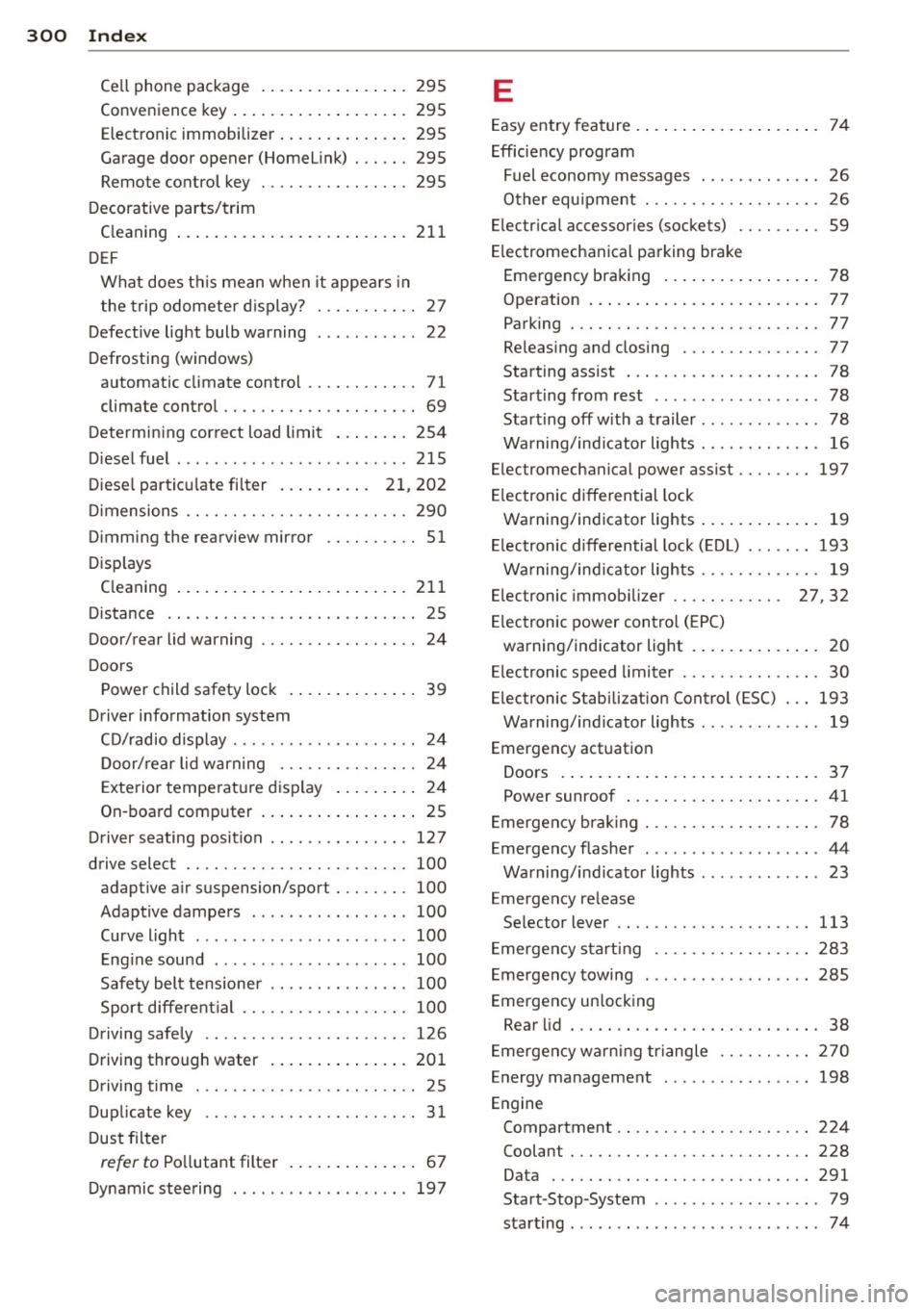
300 Index
Cell phone package .... ... .. .. .... . 295
Convenience key ....... ... .. .. .... . 295
Elect ronic immobilize r ... .. .. .. .... . 295
Garage door opener (Homel ink) . ..... 295
Remote control key ......... .. .... . 295
D ecorative parts/ trim
C leaning .... .. .. ..... ... .. .. .... . 21 1
DE F
What does t his mean when it appea rs in
the trip odometer display? ..... .. .. .. 27
Defect ive light bulb warning . . . . . . . . . . . 22
D efrosting (w indows)
automatic climate control ...... .. .. .. 71
climate contro l . . . . . . . . . . . . . . . . . . . . . 69
D etermin ing correct load limit ... .. .. . 25 4
D iese l fuel . . . . . . . . . . . . . . . . . . . . . . . . . 215
Diese l partic ulate fi lter . . . . . . . . . . 21, 202
Di mensions .. .. . .......... .. .. .. .. . 290
D imm ing the rearview mirro r .. .. ...... 51
D isp lays
C leaning
211
Di stance . . . . . . . . . . . . . . . . . . . . . . . . . . . 25
Door/rear lid warning . . . . . . . . . . . . . . . . . 24
D oors
P ower child safety lock . ... .. .. .. .. . . 39
D river info rmation system
C D/radio display . . . . . . . . . . . . . . . . . . . . 24
D oor/ rear lid warning . . . . . . . . . . . . . . . 24
E xte rior tempe rat ure d isp lay ..... .. . . 24
On-boa rd computer . . . . . . . . . . . . . . . . . 25
D river seating position .. .. .. .. .. .. .. .
drive select
. . .. . .......... .. .. .... .
adaptive a ir suspension/sport . .. .. .. .
Adaptive dampe rs ......... ... .. .. .
Curve light .... .... .... .. .. .. .. .. .
E ng ine sound ............. ... .. .. .
Safety bel t tensioner ...... .... .... .
Sport different ia l ......... .. .. .... .
Driving safely
Driving through water 127
100
100
100
100
100
100
100
126
201
Dr iving t ime .............. .... ...... 25
Dup licate key . . . . . . . . . . . . . . . . . . . . . . . 31
D ust filter
refer to Po llutant filte r . . . . . . . . . . . . . . 67
D ynamic stee ring 197
E
Easy entry fea ture . . . . . . . . . . . . . . . . . . . . 7 4
E fficie ncy prog ram
Fuel economy messages . . . . . . . . . . . . . 26
O ther equ ipment .............. .. .. . 26
E lectr ica l accessories (sockets) ...... .. . 59
El ec tromechanica l pa rking brake
Emergency brak ing ..... .... ... .. .. . 78
Operation . . . . . . . . . . . . . . . . . . . . . . . . . 77
Pa rking ... .. .. .. .. ........... .... . 77
Re leas ing and closing .............. . 77
Starting assist . . . . . . . . . . . . . . . . . . . . . 78
Starting from rest . . . . . . . . . . . . . . . . . . 78
Start ing off w ith a t railer . . . . . . . . . . . . . 78
Wa rning/ind icator lights ........ .. .. . 16
E lectromechanical power assist .. .. .. .. 197
El ectronic differential lock
Warning/ind icator lights ..... ... .. .. . 19
El ectronic d ifferential lock ( EDL) . .. .... 193
Warning/ind icator lights ........ .. .. . 19
E lectronic i mm ob i Lizer . . . . . . . . . . . . 2 7, 3 2
El ec tronic power contro l (EPC)
warning/indicator light . . . . . . . . . . . . . . 20
El ectronic speed limi ter .......... .. .. . 30
E lectronic Stabilization Contro l (ESC) ... 193
Warning/ind icator lights .. ... .... _ . _ . 19
Emergency actuation Doors . ... .... .. .. ... .. ..... ... .. . 37
Power sunroof ... ................. . 41
E merge ncy bra king .............. .... . 78
Emergency flashe r .... .. ..... ... .. . _ . 44
Warning/ind icator lights . ....... .. .. . 23
Emergency re lease
Se lector lever ................. .... 113
E mergency s tart ing
E mergency towing
Emergency un locking 2
83
285
Rea r lid . .. .. .. .. ............... .. . 38
E mergency warni ng triangle .... .. .. . .
E n ergy management .... .. ... .... .
Engine Compartment .. .. ... .......... ... .
Coolant
... .... ...................
2 70
198
224
228
Data . .... .... ................... 291
Start-Stop -System ..... .. ... .... _ . _ . 79
sta rting ...... ... .. .......... ... .. . 74